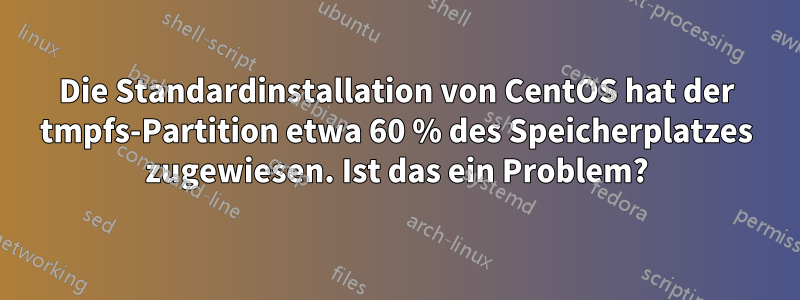
Ich habe einen CentOS-Server installiert, der als Xen-Hypervisor verwendet wird. Der Server verfügt über zwei Intel(R) Xeon(R) CPU E5620 und 148 GB Arbeitsspeicher. Das Betriebssystem wurde auf einem 120 GB SSD-Laufwerk installiert. Nach der Installation stellte ich fest, dass die tmpfs-Partition etwa 60 % des Laufwerks einnahm. Auch wenn ich für das Betriebssystem nicht viel Platz benötige, wird es mit der 71 GB tmp-Partition ein Problem geben? Danke für jeden Kommentar.
[root@cloud ~]# df -h
Filesystem Size Used Avail Use% Mounted on
/dev/mapper/VolGroup00-LogVol00
55G 1.1G 51G 3% /
/dev/sda1 99M 13M 82M 14% /boot
tmpfs 71G 0 71G 0% /dev/shm
BEARBEITEN:
[root@cloud ~]# fdisk -l
Disk /dev/sda: 120.0 GB, 120034123776 bytes
255 heads, 63 sectors/track, 14593 cylinders
Units = cylinders of 16065 * 512 = 8225280 bytes
Device Boot Start End Blocks Id System
/dev/sda1 * 1 13 104391 83 Linux
/dev/sda2 14 14593 117113850 8e Linux LVM
[root@cloud ~]# vgdisplay
--- Volume group ---
VG Name VolGroup00
System ID
Format lvm2
Metadata Areas 1
Metadata Sequence No 3
VG Access read/write
VG Status resizable
MAX LV 0
Cur LV 2
Open LV 2
Max PV 0
Cur PV 1
Act PV 1
VG Size 111.69 GB
PE Size 32.00 MB
Total PE 3574
Alloc PE / Size 3573 / 111.66 GB
Free PE / Size 1 / 32.00 MB
VG UUID 37dcLa-zJv6-i2j3-3Xvk-keXO-HJDh-UDgQ8l
[root@cloud ~]# lvdisplay
--- Logical volume ---
LV Name /dev/VolGroup00/LogVol00
VG Name VolGroup00
LV UUID Kj5LoJ-kCOq-MWhV-Wc3s-kds1-AsNE-cs9Ibh
LV Write Access read/write
LV Status available
# open 1
LV Size 56.50 GB
Current LE 1808
Segments 1
Allocation inherit
Read ahead sectors auto
- currently set to 256
Block device 253:0
--- Logical volume ---
LV Name /dev/VolGroup00/LogVol01
VG Name VolGroup00
LV UUID 4h7uvI-as7G-OTWE-ufea-CqqO-ws76-WolJCt
LV Write Access read/write
LV Status available
# open 1
LV Size 55.16 GB
Current LE 1765
Segments 1
Allocation inherit
Read ahead sectors auto
- currently set to 256
Block device 253:1
Antwort1
Die tmpfsPartition, die Sie aufgelistet sehen, ist die/dev/shm geteilte Erinnerung"Ramdisk". Das entspricht standardmäßig 50 % Ihres physischen RAM. Dies hat nichts mit Ihrem Betriebssystemlaufwerk (/dev/mapper/VolGroup00-LogVol00) zu tun, das unter gemountet ist /. Sie müssen sich hier also keine Sorgen machen. Ihr Systemlaufwerk ist derzeit 55 GB groß und Sie verwenden nur 1,1 GB davon.
Eine ausführliche Beschreibung finden Sie unter:http://www.cyberciti.biz/tips/what-is-devshm-and-its-practical-usage.html
Antwort2
Ich würde nicht empfehlen, so viel Speicher zu verwenden für/dev/shmauf einem Dom0.
Sie haben zwei Möglichkeiten:
- Begrenzen Sie die Größe von /dev/shm mit der entsprechenden Mount-Option (z. B. auf 1 GB)
- Begrenzen Sie den für Dom0 verfügbaren Speicher (z. B. auf 2 GB RAM).
Letzteres wird empfohlen vonSuSE. Der Standardwert für /dev/shm ist die Hälfte des verfügbaren RAM – was auf einem Rechner, der viel RAM verwendet (wie einem Dom0), zu Problemen führen kann.


